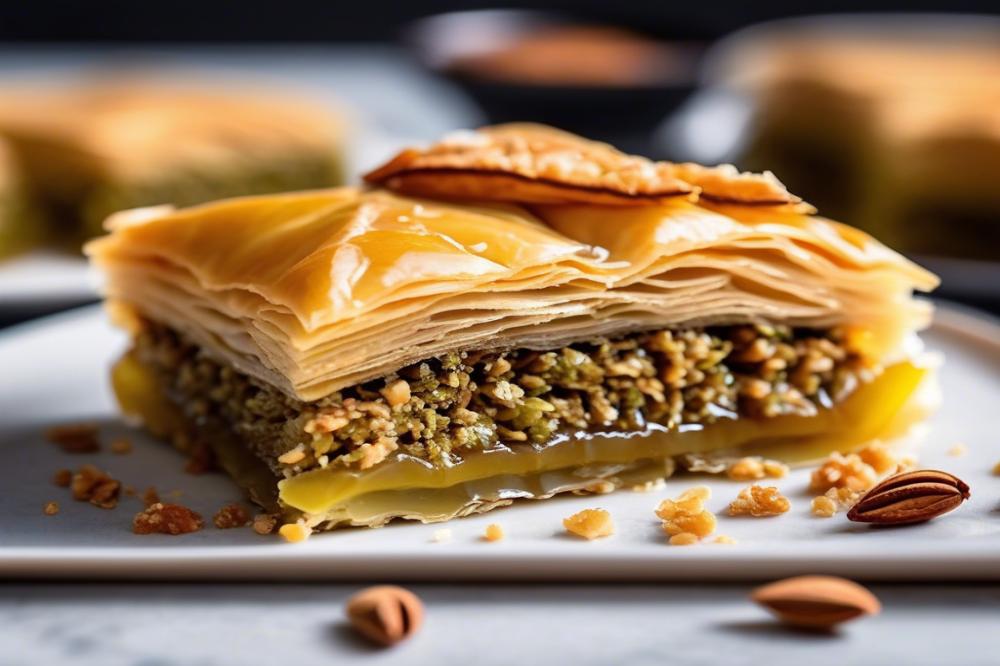Understanding Baklava: A Delightful Treasure
Baklava is a famous Greek pastry that has captured the hearts of many. This sweet dessert is made from layers of phyllo dough, filled with nuts like walnuts and pistachios. It is often spiced with cinnamon and drenched in honey syrup, creating a rich flavor that is hard to resist. The texture is a beautiful combination of crunchy and tender, which makes every bite an experience.
In the world of Mediterranean cuisine, baklava holds a significant place. It symbolizes tradition and celebration across many cultures in the region. Families often prepare this dessert during special occasions, sharing it with loved ones. The layers of this delicacy represent the richness of life and the importance of community.
This article will guide you through making this traditional recipe from scratch. First, we will discuss the ingredients needed to create the perfect baklava. Then, steps for assembling the layers and preparing the sweet syrup will be covered. Finally, an overview will be provided on how to serve and enjoy this delightful treat. Prepare yourself to embark on a culinary journey that connects you to the heart of Greece!
Understanding Baklava
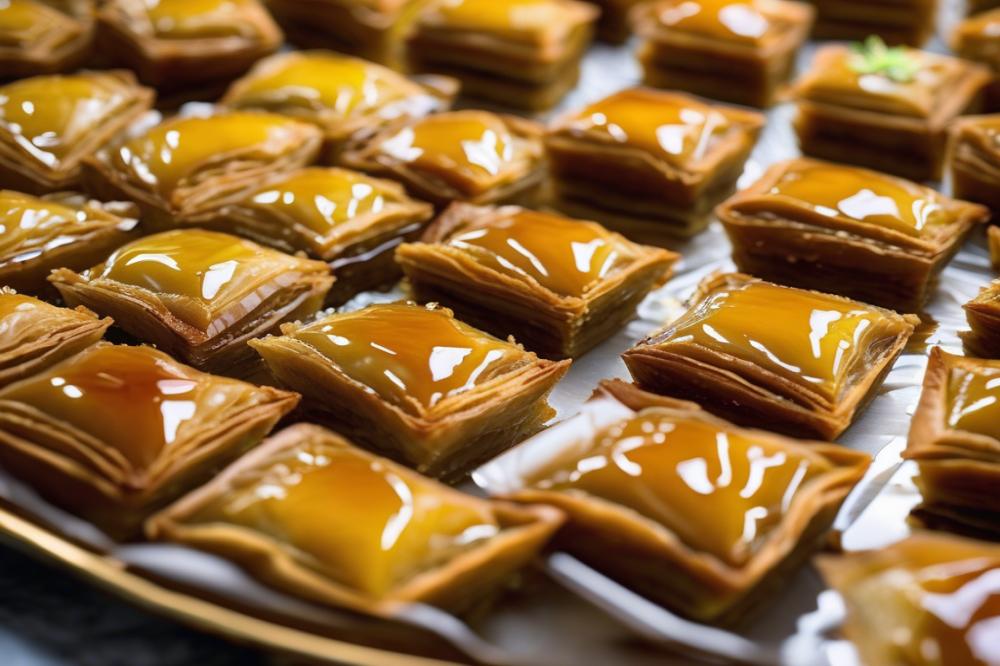
The origins of this delicious dessert are not entirely clear. Many believe that baklava traces its roots back to ancient civilizations of the Mediterranean. Greeks, Turks, and Arabs each hold claims to this beloved pastry. The name itself may come from the Turkish word “bakla,” meaning to wrap. Over centuries, this treat has evolved, yet its appeal remains strong in Greece.
Across different cultures, variations of this dessert exist. For instance, in Turkey, people often use pistachios, adding a rich green color to the layers. Meanwhile, in regions like Lebanon, rosewater or orange blossom gives a unique twist to the flavor. Each culture has its special touch, showcasing local ingredients and customs.
The Importance of Layers
The layered nature of baklava is crucial to the overall texture and taste. phyllo dough, thin and delicate, provides a crispy exterior that contrasts beautifully with the nutty filling inside. This filling usually includes walnuts or pistachios combined with cinnamon, which adds a warming spice. As you bite into a piece, the layers melt in your mouth while the sweet honey ties everything together.
A traditional recipe typically calls for at least twenty layers of phyllo. This requires patience but results in a spectacular treat. Once baked, the sweet syrup poured over it transforms this dessert into a sticky and indulgent delight. Each bite delivers a satisfying crunch followed by the soft, sweet interior filled with nuts.
Baklava holds a special place in Greek culture. It often appears during holidays and celebrations, symbolizing hospitality and joy. Families enjoy making it together, passing down recipes through generations. Creating this dish is more than simply preparing a dessert; it’s about sharing traditions and creating lasting memories.
Ingredients for Traditional Greek Baklava
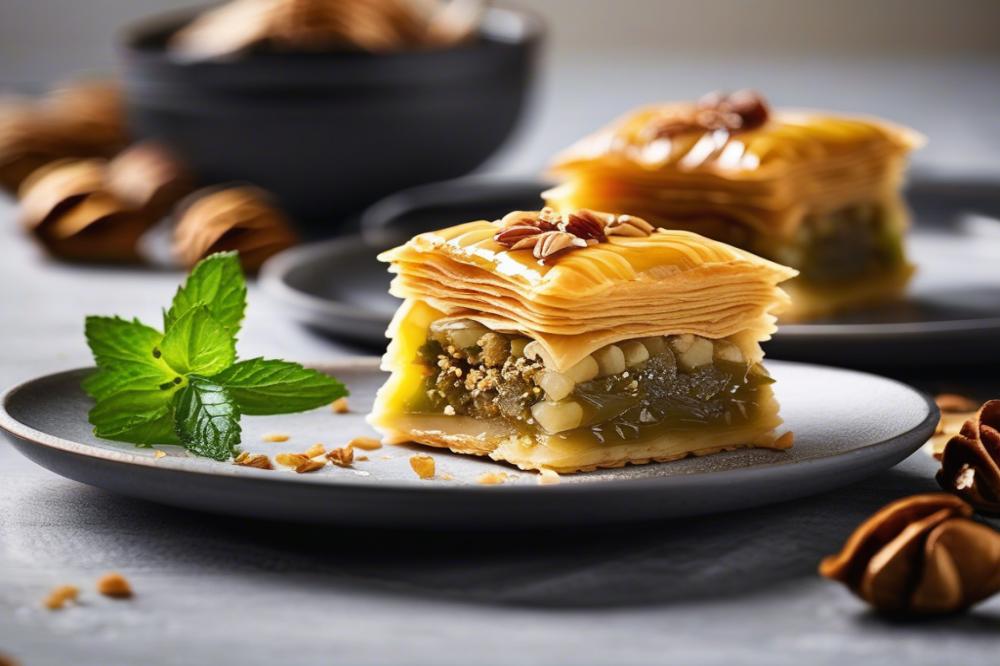
Creating the perfect Mediterranean dessert starts with the right ingredients. To make this delicious dish, here is a detailed list of what you will need:
- 1 package of phyllo dough (16 oz)
- 2 cups of walnuts, chopped
- 1 cup of pistachios, chopped
- 1 cup of unsalted butter, melted
- 1 cup of honey
- 1 cup of granulated sugar
- 1 teaspoon of ground cinnamon
- 1 cup of water
Phyllo dough is essential for creating the many layers that define this traditional recipe. You can find it in the frozen section of most grocery stores. When selecting walnuts and pistachios, look for the freshest nuts you can find. Freshness will enhance the flavor significantly. Chopping the nuts yourself can also maintain their taste and texture, rather than opting for pre-chopped versions.
As you gather your ingredients, pay attention to the quality of honey. A rich, quality honey will contribute to the final sweetness and give a deep flavor. When it comes to sugar, granulated is the best choice for this recipe. It dissolves well in the syrup, blending effortlessly with water and honey during cooking. Ground cinnamon is another crucial component, offering a warm spice that complements the nuts beautifully.
Melting unsalted butter allows you to control the saltiness of your dessert. This butter will be brushed delicately onto the phyllo sheets, creating a flaky, golden texture once baked. Proper layering is vital; each phyllo sheet needs to be coated to achieve that lovely crunch.
Every ingredient works harmoniously to create a sweet, decadent dessert that is beloved in many cultures. Make sure to store your ingredients properly before use, as this can affect their quality. With these carefully selected ingredients in hand, you will be ready to embark on the rewarding journey of making baklava.
Method for Preparing and Assembling Baklava
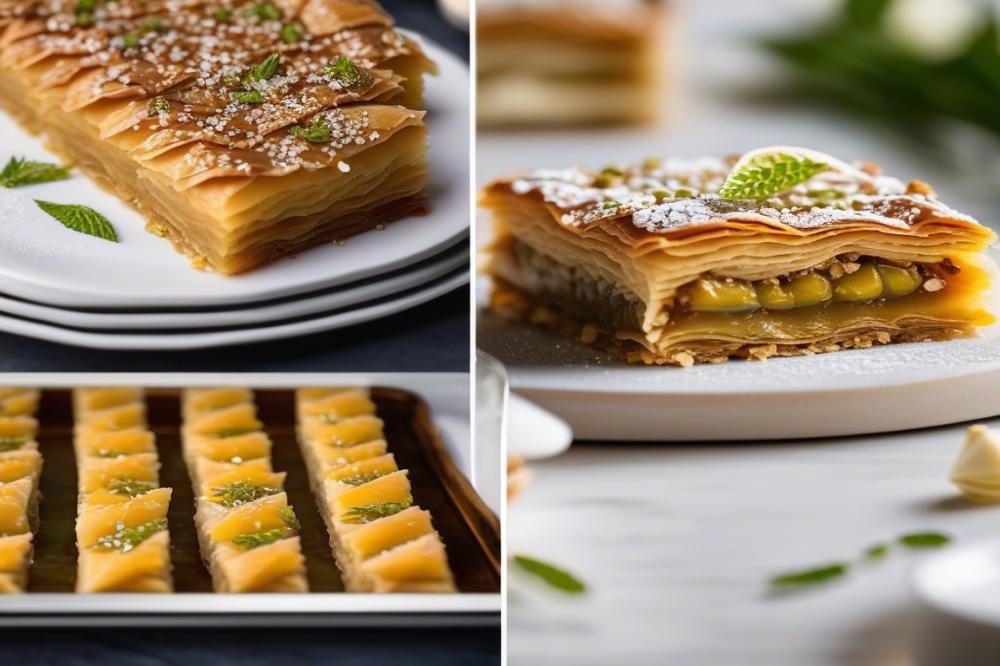
Preparing the Nut Filling
To start, gather a mix of walnuts and pistachios. Chop them finely, making sure not to grind them into dust. Add sugar and a touch of cinnamon to the nuts for extra flavor. This mixture should have a nice balance of crunch and sweetness. Set this bowl aside, letting the flavors blend.
Preparing the Phyllo Layers
Next, take out the phyllo dough. It comes in thin sheets, which create those wonderful layers. Lay the sheets on a clean counter, keeping them covered with a damp cloth to prevent them from drying out. Melt some butter in a small bowl. Using a brush, apply a light coat of butter to the bottom of your baking pan. This will keep everything from sticking.
Assembling the Dessert
Begin layering the phyllo sheets in the pan. Lay down one sheet, brush it with butter, then add another. Repeat this process for about seven or eight sheets. Once you’ve created a solid base, evenly spread half of the nut mixture over the phyllo. Then, layer more sheets on top, again brushing each one with melted butter. Repeat the layering process and finish with more nuts. Top it all with a final few sheets of phyllo, making sure to brush each one. When you reach the end, trim any excess dough.
Baking and Preparing the Syrup
Preheat your oven to 350°F (175°C). Score the top of the dessert into diamond shapes using a sharp knife. This helps the syrup soak in later. Bake your creation for about 45 minutes, or until it’s golden brown and crispy. Meanwhile, prepare a sweet syrup. Combine equal parts honey and water in a saucepan, adding a few sticks of cinnamon for added depth. Bring the mixture to a boil, then allow it to simmer for about 10 minutes until it thickens slightly.
Allowing Baklava to Set
Once baked, remove the dessert from the oven and immediately pour the hot syrup over it. This should be done while it’s still warm, allowing the syrup to seep into every layer. Allow everything to cool completely at room temperature. For the best results, let it sit for several hours or overnight. Enjoy this traditional Mediterranean treat that will leave a lasting impression.
Nutritional Information
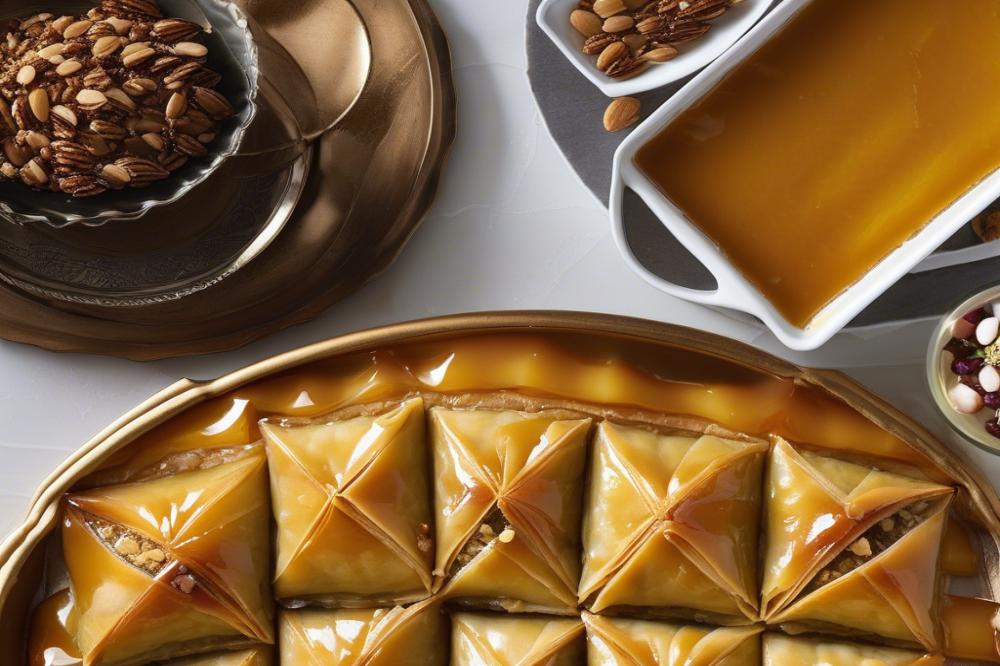
Baklava is a delicious dessert with a range of ingredients that come together to create its iconic taste. Understanding the caloric breakdown of these components can help you appreciate this traditional recipe even more. Phyllo dough, used for the layers, is relatively low in calories compared to sweets packed with butter. However, the honey and nuts contribute significantly to the overall calorie count.
Walnuts and pistachios add healthy fats and protein to the dish. Nuts are nutrient-dense, containing vitamins and minerals that can benefit your health. These ingredients offer antioxidants which may help in reducing inflammation. Honey provides natural sweetness along with some vitamins, making it a better alternative to refined sugar.
Consider the role of cinnamon. This spice not only adds flavor but also has potential health benefits. Many studies suggest that cinnamon can help regulate blood sugar levels and may have antioxidant properties. Keeping this in mind, enjoying dessert doesn’t have to feel like a guilty pleasure.
When indulging in sweets, moderation is key. A small serving of baklava satisfies cravings without going overboard. Pairing it with a cup of tea or coffee might enhance the experience while also keeping portion sizes in check. Remember, desserts from the Mediterranean can be both sweet and wholesome, striking a balance between pleasure and nutrition.
Serving and Storing Baklava
Best Ways to Serve Baklava
Serving this delicious dessert is an art in itself. Slicing it into small squares or diamond shapes allows everyone to enjoy a piece. Offering it on a decorative plate adds a touch of elegance. Simple garnishes like crushed pistachios or a sprinkle of cinnamon can enhance its presentation. This sweet delight is best enjoyed at room temperature, but some prefer it chilled. Serve it alone or alongside a dollop of whipped cream for a richer experience.
Storing Leftovers for Freshness
Leftovers require careful storage to maintain their quality. Placing them in an airtight container is crucial. Ideally, keep them at room temperature for a few days. For longer storage, refrigeration is an option, but it may affect texture slightly. If you notice any excess moisture, use parchment paper between layers to absorb it. The goal is to keep those precious layers crisp and delightful for as long as possible.
Pairing Baklava with Beverages
Finding the right beverage to accompany this Mediterranean treat can elevate the experience. Traditional Greek coffee is a popular choice, balancing the sweetness perfectly. A cup of herbal tea can also complement the flavors beautifully. For those who prefer something cooler, a light sparkling water refreshes the palate. Some enjoy pairing it with a dessert wine, enhancing the sweetness even further. Simple choices will always work well; just aim for balance.
Bringing the Flavors of Greece Home
The preparation of traditional Greek baklava is truly a labor of love. Layering delicate sheets of phyllo with a blend of finely chopped walnuts creates an incredible texture. Each step, from melting the butter to pouring sweet syrup over the warm dessert, is essential for achieving that perfect balance of flavors. Watching the golden layers transform in the oven is a rewarding experience.
Making baklava at home can be a fun and satisfying challenge. It allows you to delve into a culinary tradition that has been passed down for generations. Gather your ingredients, follow the steps carefully, and don’t hesitate to experiment a little. The payoff is well worth the effort. Sharing a piece with family or friends can bring a sense of joy and accomplishment.
This dessert is not just food. It carries rich cultural significance in Greek celebrations and gatherings. Often served at weddings and holidays, its sweetness symbolizes prosperity and happiness. By making it yourself, you participate in a beautiful tradition that connects you to the past. So, roll up your sleeves and bring a taste of Greece into your kitchen. You might find that it becomes a beloved part of your own celebrations.

